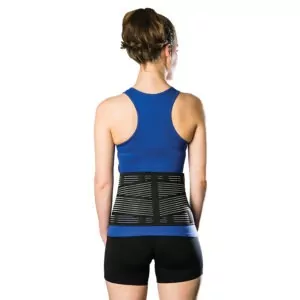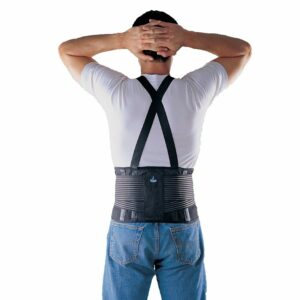Spondylolisthesis
Updated:
What is a spondylolisthesis?
A spondylolisthesis is a condition characterised by forward slipping of one vertebra on another.
The spine comprises of many bones known as vertebrae. Each vertebra connects with the vertebra above and below via two types of joints: the facet joints on either side of the spine and the disc centrally (figure 1). These joints and bones of the spine are designed to support body weight, assist with holding the vertebra in alignment, protect the spinal cord and enable spinal movement.
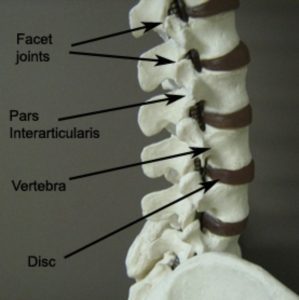
Occasionally, anatomical structures of the spine responsible for holding the vertebra in alignment may not develop correctly during early childhood or birth or may be damaged during overuse or trauma. This may allow one vertebra to slip forwards relative to the vertebra below. When this occurs the condition is known as a spondylolisthesis.
A spondylolisthesis is graded according to the degree of slip of the vertebra relative to the vertebra below. A Grade I slip indicates a slip of less than 25%, Grade II – 50%, Grade III – 75% and Grade IV > 75%. A spondylolisthesis most commonly affects the L5 / S1 level of the spine (at the base of the lower back), with the L5 vertebra slipping forwards relative to the S1 vertebra below.
Causes of spondylolisthesis
A spondylolisthesis typically occurs due to defects in the bone (vertebra) which usually develop during childhood and is most commonly seen in children between the ages of 9 and 14. The defect is due to an absence of a section of bone on each side of the vertebral column which assists in holding the vertebra in alignment. This section of bone is known as the ‘pars interarticularis’ (figure 1).
Although uncommon, a spondylolisthesis may also occur due to stress fractures in each pars interarticularis. This may occur due to excessive athletic or sporting activity involving repetitive hyperextension (backward bending) of the spine (such as gymnastics or fast bowling in cricket).
Occasionally, patients may develop a spondylolisthesis following a traumatic injury to the lower back, (such as a motor vehicle accident), following significant degenerative changes to the joints and bones of the spine over time (usually associated with overuse or aging) or due to congenital abnormalities associated with malformation of the facets of the spine.
In rare cases, a spondylolisthesis may occur due to a defect in the bone associated with conditions such as a tumour.
Signs and symptoms of a spondylolisthesis
Patients with a Grade 1 spondylolisthesis may experience little or no symptoms and may be completely unaware of the defect. As the condition progresses patients may begin to experience lower back pain, ache and / or stiffness. In more severe cases involving spinal cord compression, severe pain, muscle spasm, shooting pain, pins and needles, numbness, burning sensations or weakness may be experienced in the lower back, buttocks, thighs, lower legs or feet on one or both sides of the body. Loss of bladder or bowel control may also be experienced in rare cases.
Generally, patients with this condition experience an increase in symptoms during activities that repetitively, continuously or forcefully straighten or extend the spine (figure 2). Symptoms may also increase during activities that place weight on the spine (such as lifting, prolonged standing, walking etc.). Conversely, symptoms tend to ease during activities that bend the spine forwards (e.g. sitting).
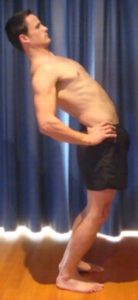
Diagnosis of a spondylolisthesis
A thorough subjective and objective examination from an experienced physiotherapist combined with appropriate investigations such as an X-Ray, CT scan or MRI are usually required to confirm diagnosis of a spondylolisthesis and determine the severity of the condition and cause of symptoms. X-ray investigation is usually best performed in the position that reproduces the patient’s pain.
Treatment for a spondylolisthesis

Members Only ContentBecome a PhysioAdvisor Member to gain full access to this exclusive content. For more details see Become a Member. Already a member? Login Now
Prognosis of a spondylolisthesis
Most cases of spondylolisthesis (particularly grades I and II) have an excellent outcome with appropriate conservative management. Patients can generally remain active, experiencing little or no symptoms, although occasionally, minor lifestyle modifications may be required.
Most patients with more severe conditions (grades III and IV) can also have a great long term outcome, with appropriate conservative management. These patients can also generally remain active, with minimal symptoms, although they are more likely to require more significant lifestyle modifications (including avoidance of high speed or contact sports for all of these patients) and are more likely to experience more significant symptoms including neurological signs (such as pins and needles, numbness or weakness).
In patients with a grade III or IV spondylolisthesis, surgery may be indicated, particularly when there is evidence of slip progression, when symptoms are still experienced after a 6 month non-surgical period or in growing children with a slip of greater than 50%. Patients who undergo surgical intervention usually have a good outcome similar to those Grade III and IV spondylolisthesis patients who do not require surgical management. Rehabilitation following surgery (including appropriate physiotherapy) typically lasts many months.
Contributing factors to the development of symptoms of a spondylolisthesis
There are several factors that may contribute to the development of symptoms in patients with this condition. These need to be assessed and corrected with direction from a physiotherapist and may include:
- poor posture
- poor core stability
- muscle weakness (particularly of the core and back stabilizers)
- poor flexibility (particularly of the hamstrings or hip flexors)
- joint stiffness
- muscle imbalances
- being overweight
- a sedentary lifestyle
- excessive or inappropriate activity
- inadequate recovery periods from activity
- history of injury or trauma to the lower back
- biomechanical abnormalities
- inappropriate lifting technique
Physiotherapy for a spondylolisthesis
Physiotherapy treatment for patients with this condition is vital to hasten the healing process, ensure an optimal outcome and ensure a safe return to activity. Treatment may comprise:
- soft tissue massage
- anti-lordotic bracing
- joint mobilization
- dry needling
- ice or heat treatment
- education
- activity modification advice
- biomechanical correction
- clinical Pilates
- hydrotherapy
- electrotherapy (e.g. ultrasound)
- exercises to improve flexibility, strength and core stability
- a gradual return to activity program
Other intervention for a spondylolisthesis
Despite appropriate physiotherapy management, a small percentage of patients with this condition fail to improve adequately or deteriorate. When this occurs, other intervention may be required. This may include further investigations such as X-rays, CT scan or MRI, pharmaceutical intervention, cortisone injection or assessment from an orthopaedic specialist or neurosurgeon. In patients with a grade III or IV spondylolisthesis, surgery may be indicated, particularly in rare cases when there is evidence of slip progression, when symptoms are still experienced after a 6 month non-surgical period or in growing children with a slip of greater than 50%. The treating physiotherapist can advise on appropriate management and can refer to the appropriate medical authority if it is warranted clinically.
Exercises for a spondylolisthesis
The following exercises are commonly prescribed to patients with this condition. You should discuss the suitability of these exercises with your physiotherapist prior to beginning them. Generally, they should be performed 3 times daily and only provided they do not cause or increase symptoms.
Your physiotherapist can advise when it is appropriate to begin the initial exercises and eventually progress to the intermediate, advanced and other exercises. As a general rule, addition of exercises or progression to more advanced exercises should only take place provided there is no increase in symptoms.
Initial Exercises
Transversus Abdominus Retraining
Slowly pull your belly button in “away from your belt line” and breathe normally. Your rib cage should remain relaxed and should not elevate during this process. You should be able to feel the muscle contracting if you press deeply 2cm in from the bony process at the front of your pelvis (figure 3). Practise holding this muscle at one third of a maximal contraction for as long as possible during everyday activity (e.g. when walking etc.) provided it is pain free. Repeat 3 times daily.
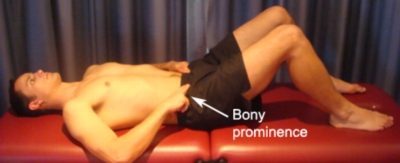
Rotation in Lying
Begin this exercise lying on your back as demonstrated (figure 4). Slowly take your knees from side to side as far as you can go without pain and provided you feel no more than a mild to moderate stretch. Repeat 10 times provided there is no increase in symptoms.
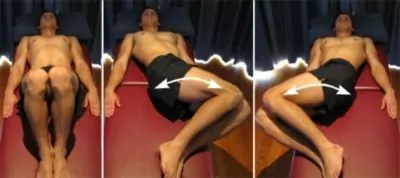
Hip Flexion
Slowly take your knee towards your chest as far as you can go without pain and provided you feel no more than a mild to moderate stretch (figure 5). Use your hands to gently bring your knee closer to your chest. Repeat 5 – 10 times on each leg provided there is no increase in symptoms.
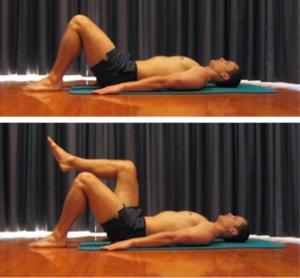
Intermediate Exercises

Members Only ContentBecome a PhysioAdvisor Member to gain full access to this exclusive content. For more details see Become a Member. Already a member? Login Now
Advanced Exercises

Members Only ContentBecome a PhysioAdvisor Member to gain full access to this exclusive content. For more details see Become a Member. Already a member? Login Now
Other Exercises

Members Only ContentBecome a PhysioAdvisor Member to gain full access to this exclusive content. For more details see Become a Member. Already a member? Login Now
Rehabilitation Protocol for a spondylolisthesis

Members Only ContentBecome a PhysioAdvisor Member to gain full access to this exclusive content. For more details see Become a Member. Already a member? Login Now
Physiotherapy products for a spondylolisthesis
Some of the most commonly recommended products by physiotherapists to help patients with this condition include:
To purchase physiotherapy products for a spondylolisthesis, click on one of the above links or visit the PhysioAdvisor Shop.
Find a Physio
Find a physiotherapist in your local area who can treat this condition.
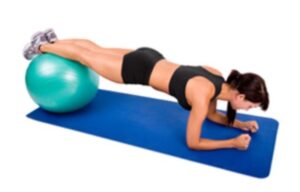 More Exercises
More Exercises
- Lower Back Strengthening Exercises
- Basic Pilates Exercises
- Core Stability Exercises
- Cardiovascular Exercise
- Hamstring Stretches
- Lower Body Stretches
- Lower Back Stretches
- Lower Body Massage Ball Exercises
- Lower Body Gym Exercises
- Balance Exercises
Recommended Reading
-
When to use Ice or Heat
-
Initial Injury Management & the R.I.C.E. Regime
Become a PhysioAdvisor Member

Link to this Page
If you would like to link to this article on your website, simply copy the code below and add it to your page:
<a href="https://physioadvisor.com.au/injuries/lower-back/spondylolisthesis”>Spondylolisthesis – PhysioAdvisor.com</a><br/>PhysioAdvisor offers detailed physiotherapy information on a lumbar spondylolisthesis including signs and symptoms, diagnosis, treatment, rehabilitation protocol, exercises, physiotherapy products and more...
Return to the top of Spondylolisthesis.


